AWM137 2/1 - Historical information and general development of the RAAF Nursing Service - Notes of History of the RAAF Nursing Service 1940-1944 - Part 10

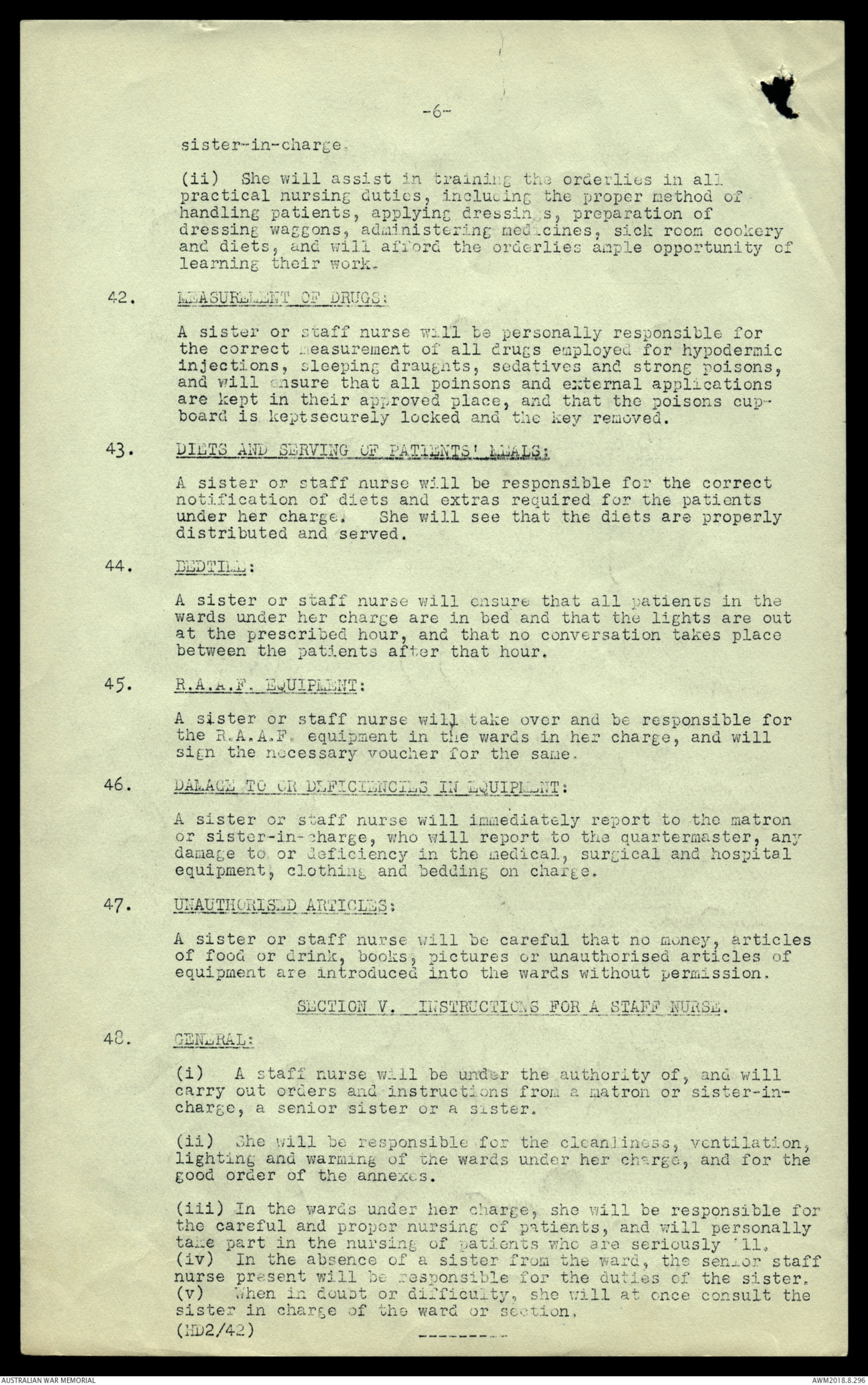
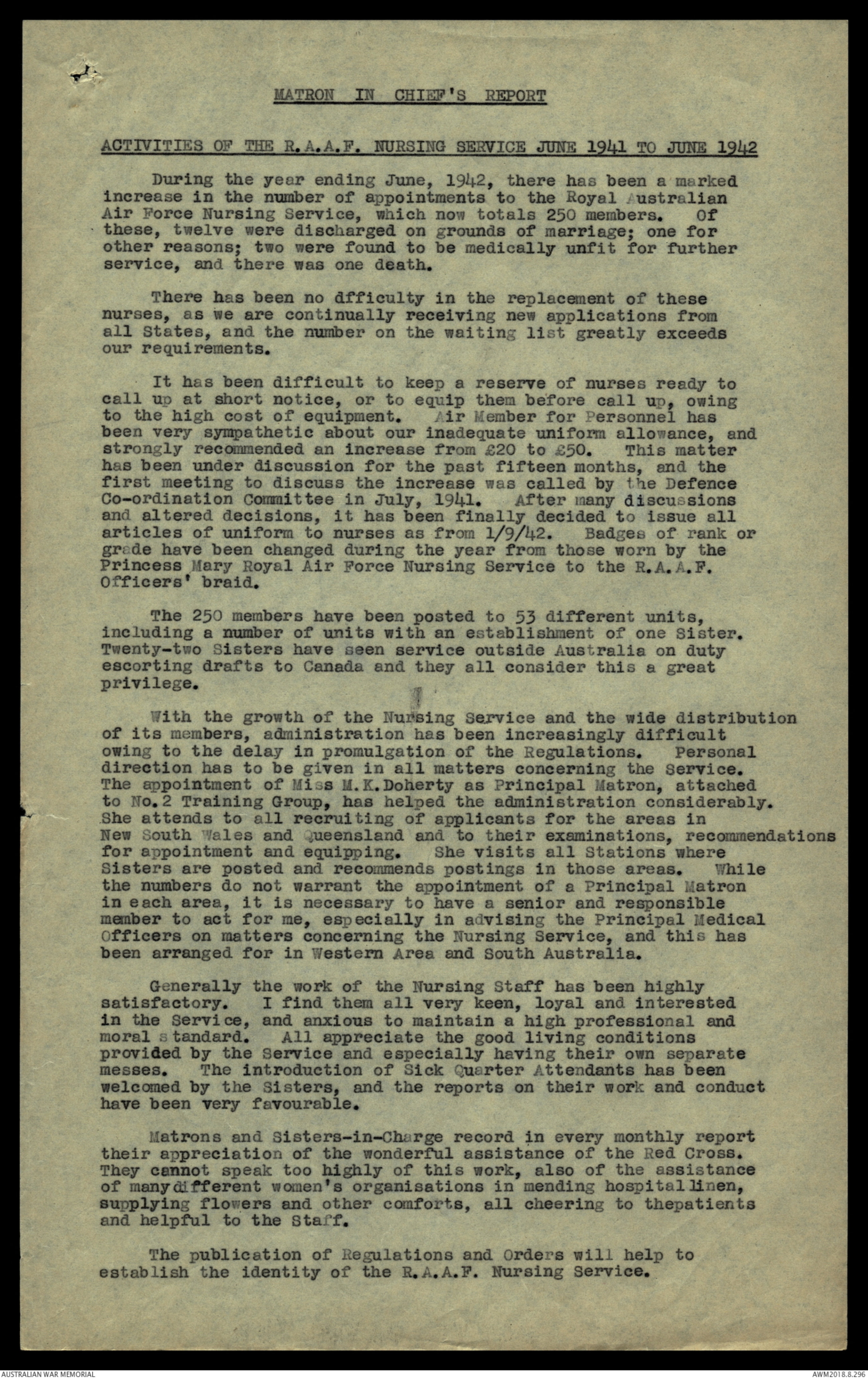
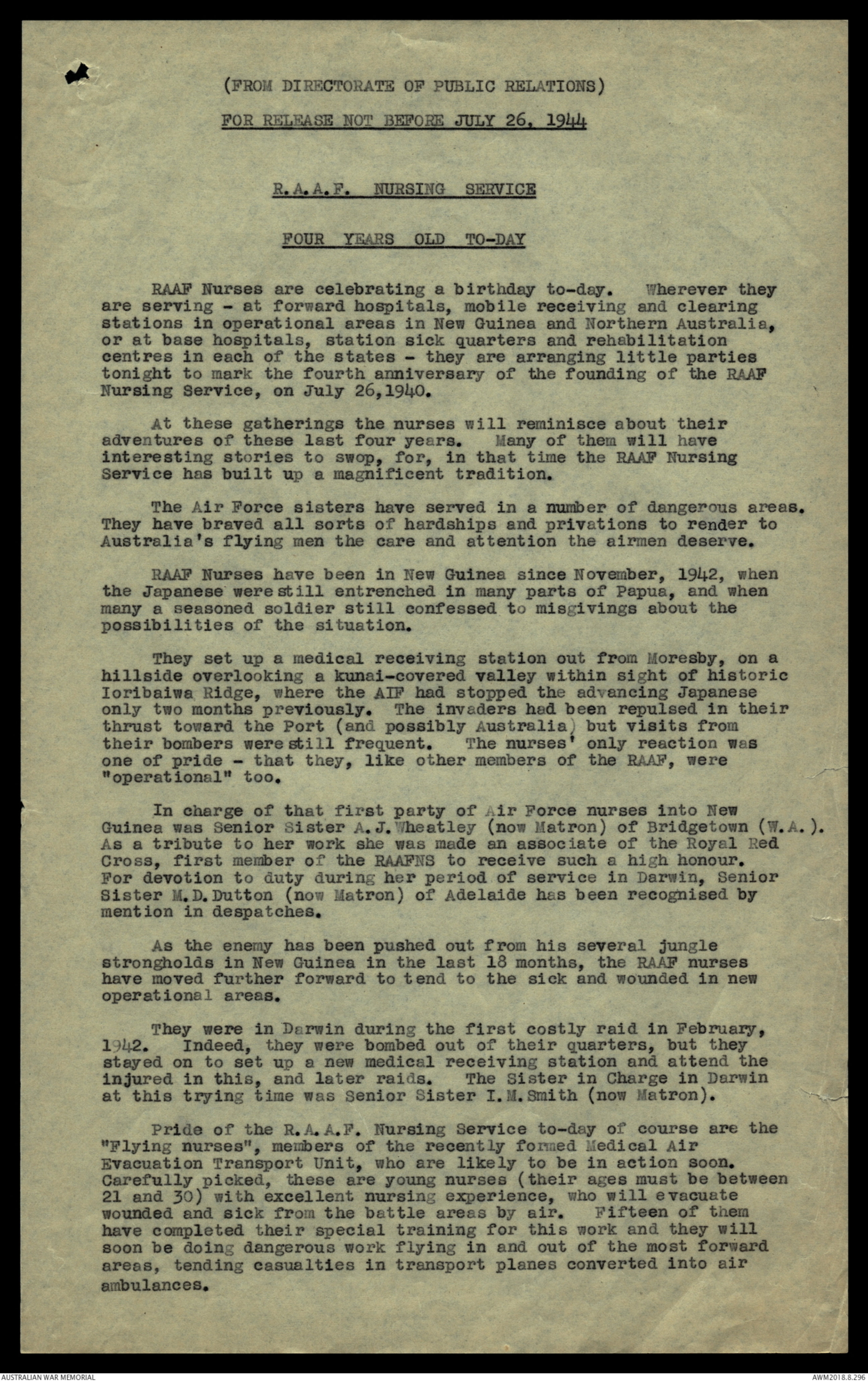
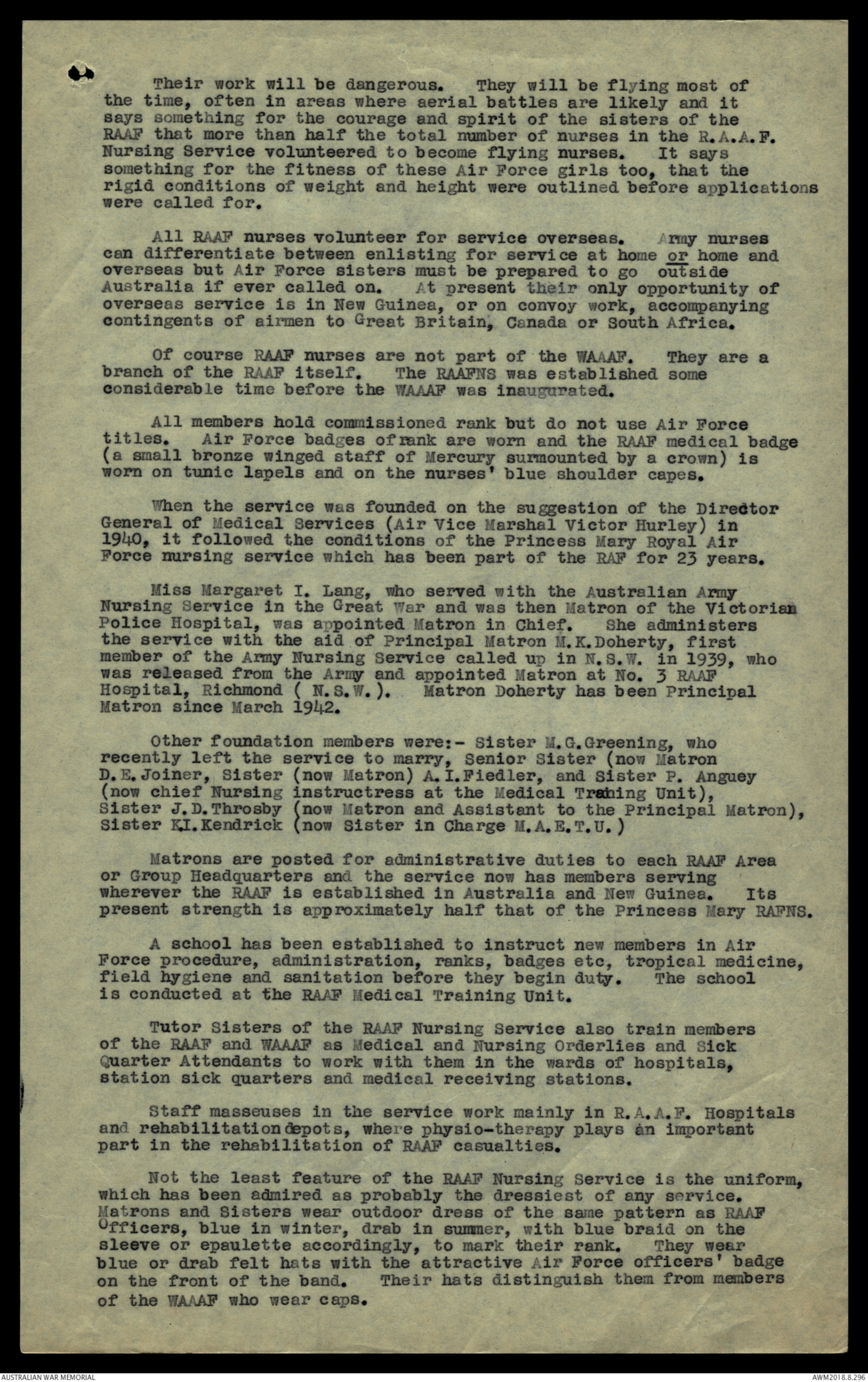

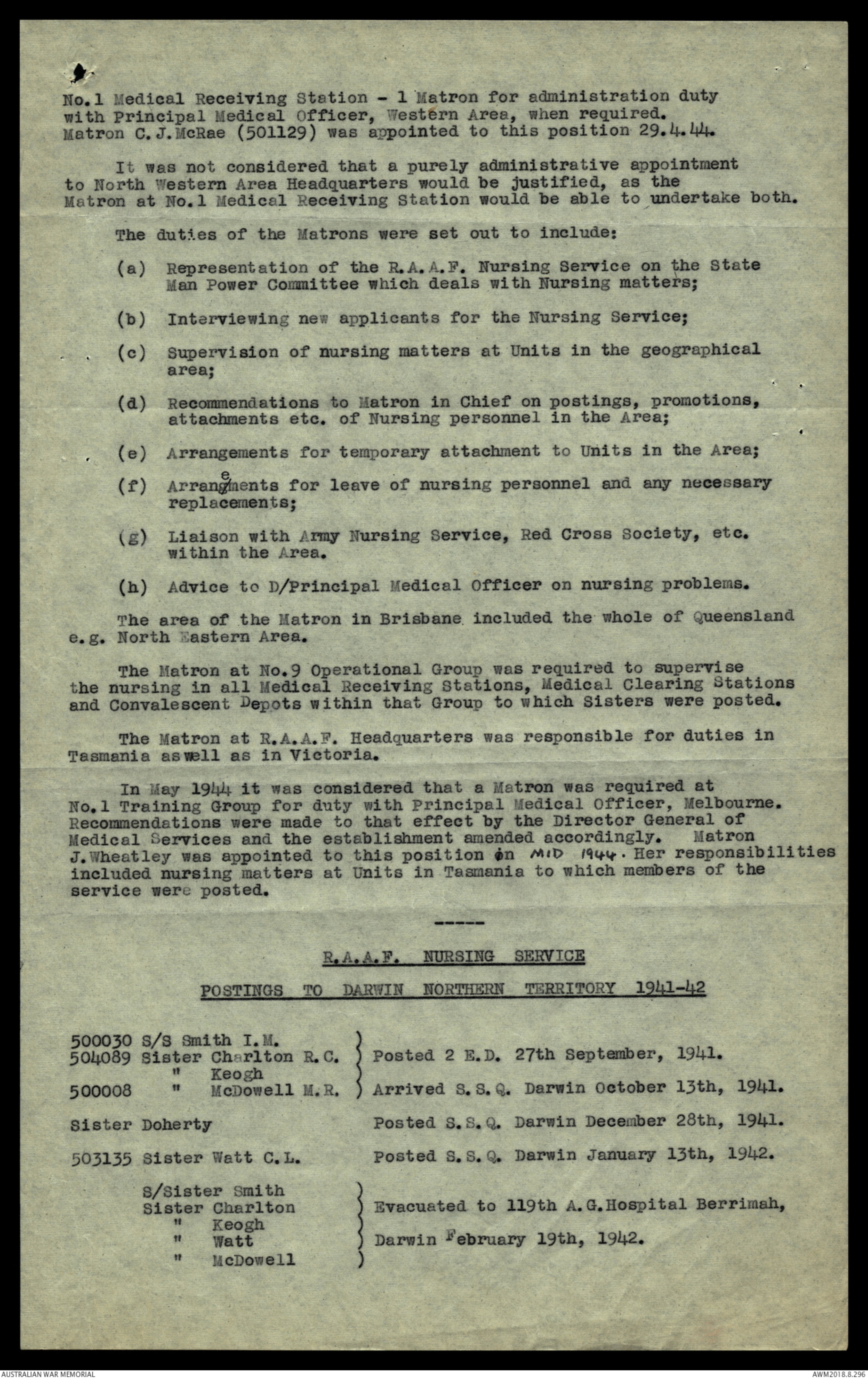
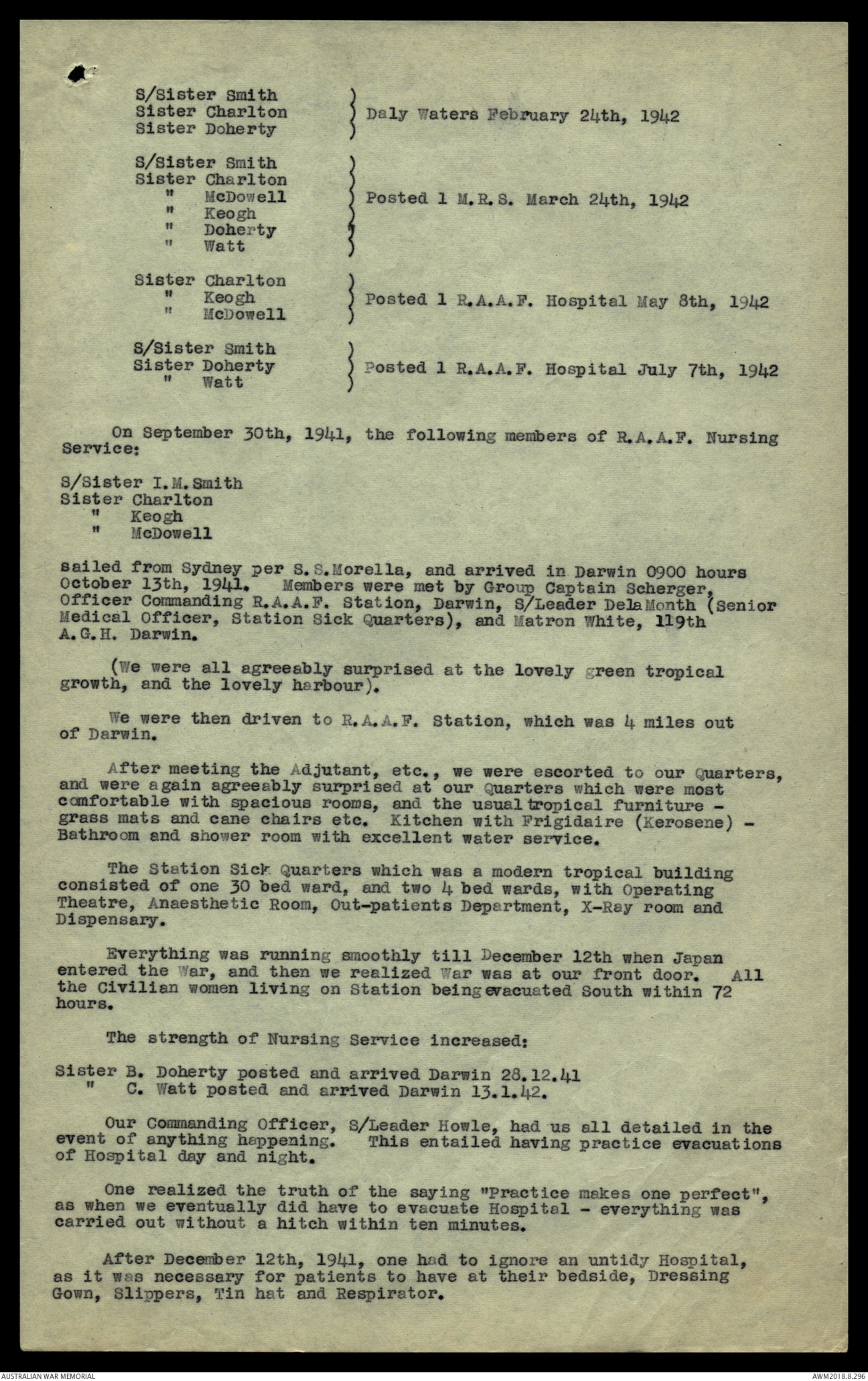
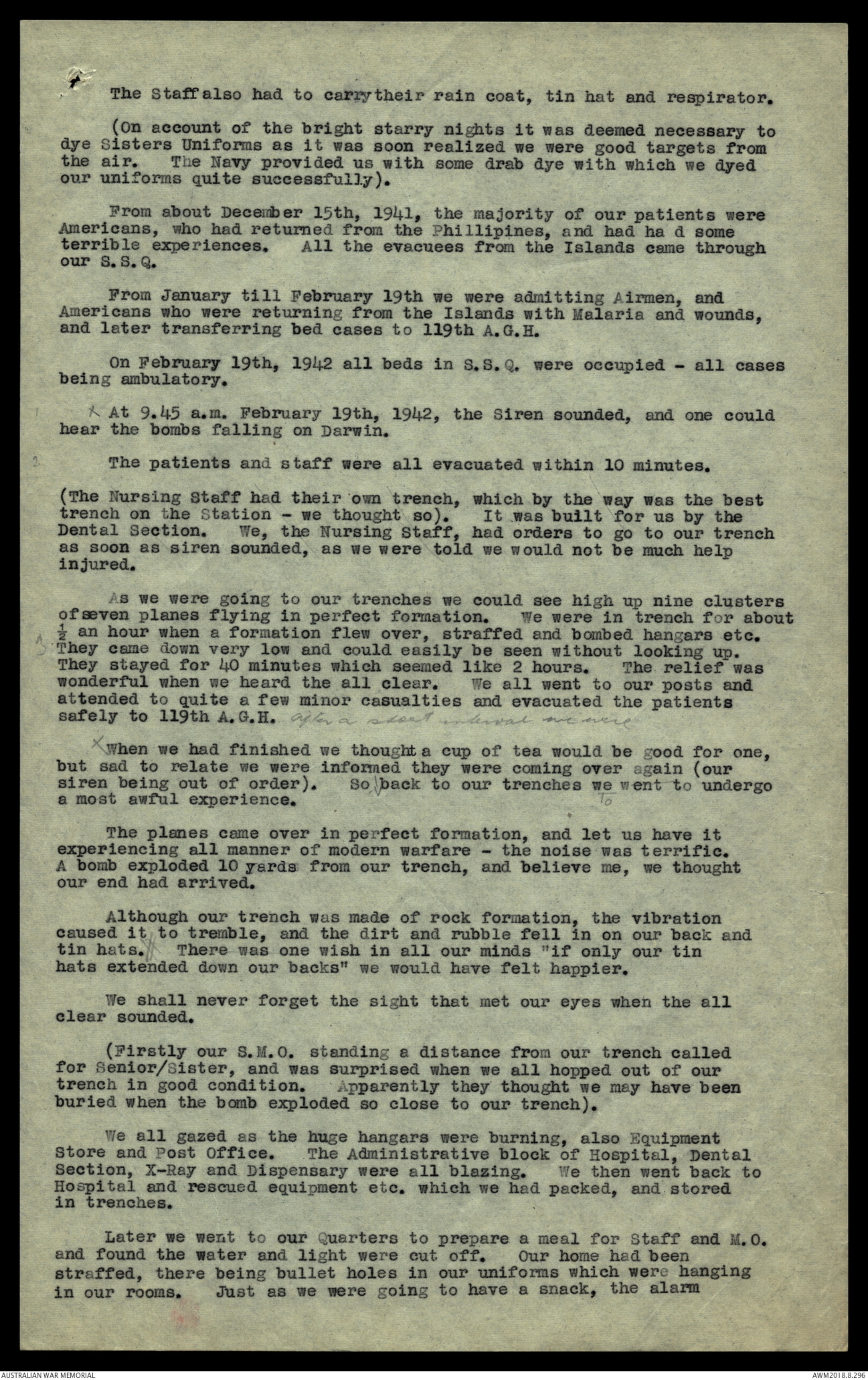
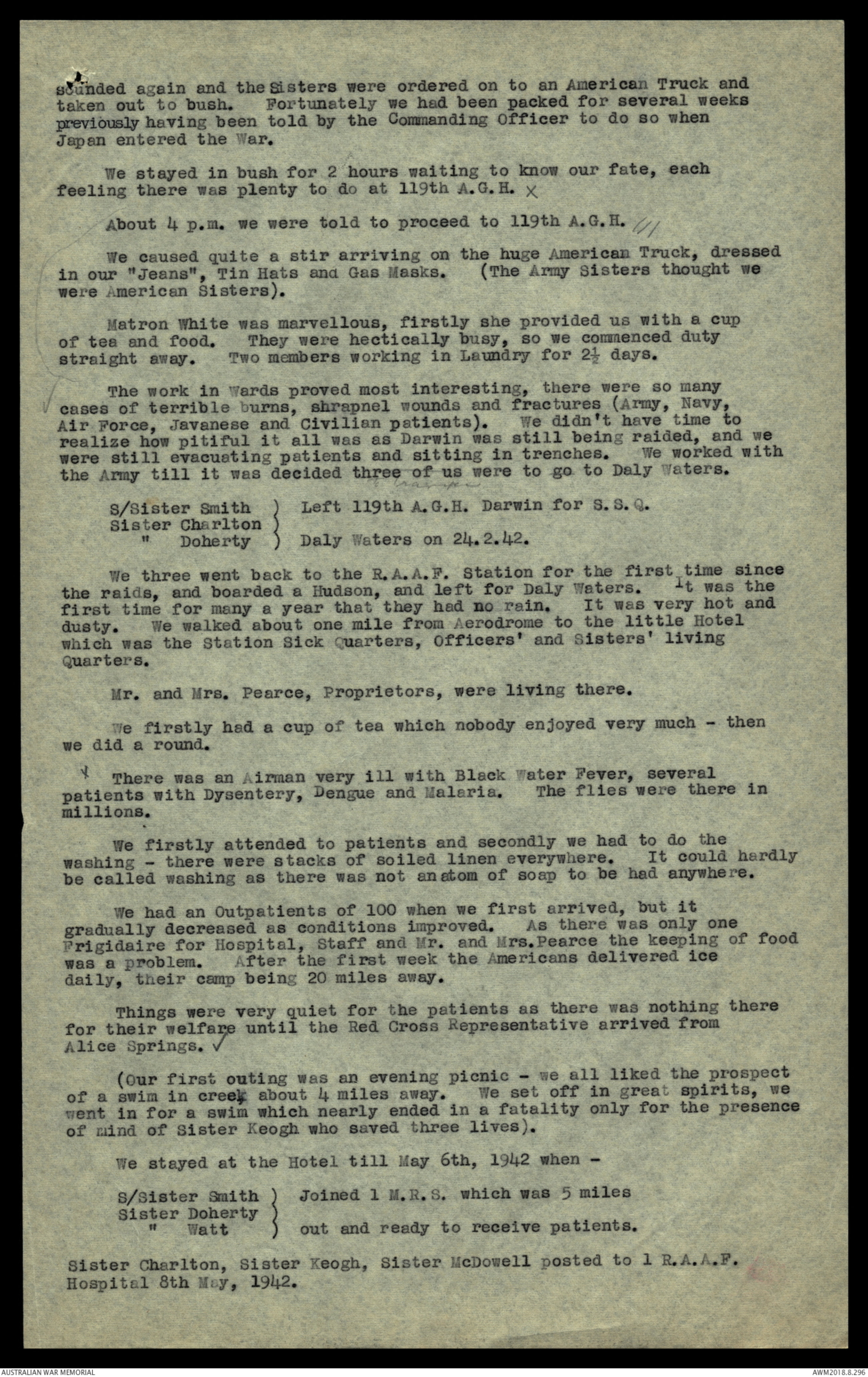
-5-
(v) When in doubt or difficulty on any matter, she will at
once consult the matron or sister-in-charge.
32. A sister will report daily to the matron or sister-in-charge
the condition of the patients in her wards, and the state of
all departments under her care. In this report, she will be
careful to mention any irregularities that may have occurred.
33. NIGHT SISTERS:
(i) Sisters of staff nurses will be detailed in rotation by
the matron of sister-in-charge for night duty, normally for a
period of one month.
(ii) Before going on duty, the night sister or staff nurse
will report herself to the matron or sister-in-charge to receive
instructions.
(iii) On coming off duty, she will personally submit her written
report to the matron or sister-in-charge.
34. WARD REPORTS:
A separate report book will be kept for each ward, in which
a full day and night report will be recorded by the sister or
staff nurse in charge of the ward.
35. ADMISSION OF PATIENTS:
A sister or staff nurse will ensure that each new patient
admitted into the ward is seen by the medical officer as soon
as possible, and that he receives suitable nourishment if
required.
36. PATIENTS SERIOUSLY ILL:
When a patient is placed on the seriously ill or danger list,
a sister or staff nurse will ensure that steps have been taken
to notify the next of kin and the Service Chaplain.
37. SPECIAL NURSE OR ORDERLY:
If a sister considers a special nurse of orderly necessary,
she will immediately report to the matron or sister-in-charge.
38. ADMINISTRATION OF ANAESTHETIC:
A sister or staff nurse may be required to be present when an
anaesthetic is administered. She will check whether permission
has been granted in the case of a minor. In special circumstances
her presence may be dispensed with by the medical
officer in charge of the case.
39. DEATH OF A PATIENT:
When a death takes place, a sister or staff nurse will ensure
that the orderly medical officer is at once informed, and on
receiving instructions, will see that the body is reverently
prepared for the mortuary, and will inform the senior warrant
officer or senior or non-commissioned officer, who will arrange
for the removal of the body with all due reverence.
40. PATIENTS FOR DISCHARGE:
A sister or staff nurse will see that patients for discharge
do not leave the wards before inspection by a medical officer.
41. INSTRUCTION OF ORDERLIES:
(i) A sister or staff nurse will give such instructions in
nursing to the orderlies as may be arranged by the matron or
-6-
sister-in-charge
(ii) She will assist in training the orderlies in all
practical nursing duties, including the proper method of
handling patients, applying dressings, preparation of
dressing waggons, administering medicines, sick room cookery
and diets, and will afford the orderlies ample opportunity of
learning their work.
42. MEASUREMENT OF DRUGS:
A sister or staff nurse will be personally responsible for
the correct measurement of all drugs employed for hypodermic
injections, sleeping draughts, sedatives and strong poisons,
and will ensure that all poinsons and external applications
are kept in their approved place, and that the poisons cupboard
is kept securely locked and the key removed.
43. DIETS AND SERVING UP PATIENTS' MEALS:
A sister or staff nurse will be responsible for the correct
notification of diets and extras required for the patients
under her charge. She will see that the diets are properly
distributed and served.
44. BEDTIME:
A sister or staff nurse will ensure that all patients in the
wards under her charge are in bed and that the lights are out
at the prescribed hour, and that no conversation takes place
between the patients after that hour.
45. R.A.AF. EQUIPMENT:
A sister or staff nurse will take over and be responsible for
the R.A.A.F. equipment in the wards in her charge, and will
sign the necessary voucher for the same.
46. DAMAGE TO OR DEFICIENCIES IN EQUIPMENT:
A sister or staff nurse will immediately report to the matron
or sister-in-charge, who will report to the quartermaster, any
damage to or deficiency in the medical, surgical and hospital
equipment, clothing and bedding on charge.
47. UNAUTHORISED ARTICLES:
A sister or staff nurse will be careful that no money, articles
of food or drink, books, pictures of unauthorised articles of
equipment are introduced into the wards without permission.
SECTION V. INSTRUCTIONS FOR STAFF NURSE.
48. GENERAL:
(i) A staff nurse will be under the authority of, and will
carry out orders and instructions from a matron or sister-in-
charge, a senior sister or a sister.
(ii) She will be responsible for the cleanliness, ventilation,
lighting and warming of the wards under her charge, and for the
good order of the annexes.
(iii) In the wards under her charge, she will be responsible for
the careful and proper nursing of patients, and will personally
take part in the nursing of patients who are seriously ill.
(iv) In the absence of a sister from the ward, the senior staff
nurse present will be responsible for the duties of the sister.
(v) When in doubt or difficulty, she will at once consult the
sister in charge of the ward or section.
(HD2/42)
MATRON IN CHIEF'S REPORT
ACTIVITIES OF THE R.A.A.F. NURSING SERVICE JUNE 1941 TO JUNE 1942
During the year ending June , 1942, there has been a marked
increase in the number of appointments to the Royal Australian
Air Force Nursing Service, which now totals 250 members. Of
these, twelve were discharged on grounds of marriage; one for
other reasons; two were found to be medically unfit for further
service, and there was one death.
There has been no difficulty in the replacement of these
nurses, as we are continually receiving new applications from
all States, and the number on the waiting list greatly exceeds
our requirements.
It has been difficult to keep a reserve of nurses ready to
call up at short notice, or to equip them before call up, owing
to the high cost of equipment. Air Member for Personnel has
been very sympathetic about our inadequate uniform allowance, and
strongly recommended an increase from £20 to £50. This matter
has been under discussion for the past fifteen months, and the
first meeting to discuss the increase was called by the Defence
Co-ordination Committee in July, 1941. After many discussions
and altered decisions, it has been finally decided to issue all
articles of uniform to nurses as from 1/9/42. Badges of rank or
grade have been changed during the year from those worn by the
Princess Mary Royal Air Force Nursing Service to the R.A.A.F.
Officers' braid.
The 250 members have been posted to 53 different units,
including a number of units with an establishment of one Sister.
Twenty-two Sisters have seen service outside Australia on duty
escorting drafts to Canada and they all consider this a great
privilege.
With the growth of the Nursing Service and the wide distribution
of its members, administration has been increasingly difficult
owing to the delay in promulgation of the Regulations. Personal
direction has to be given in all matters concerning the Service.
The appointment of Miss M.K. Doherty as Principal Matron, attached
to No. 2 Training Group, has helped the administration considerably.
She attends to all recruiting of applicants for the areas in
New South Wales and Queensland and to their examinations, recommendations
for appointment and equipping. She visits all Stations where
Sisters are posted and recommends postings in those areas. While
the numbers do not warrant the appointment of a Principal Matron
in each area, it is necessary to have a senior and responsible
member to act for me, especially in advising the Principal Medical
Officers on matters concerning the Nursing Service, and this has
been arranges for in Western Area and South Australia.
Generally the work of the Nursing Staff has been highly
satisfactory. I find them all very keen, loyal and interested
in the Service, and anxious to maintain a high professional and
moral standard. All appreciate the good living conditions
provided by the Service and especially having their own separate
messes. The introduction of Sick Quarter Attendants has been
welcomed by the Sisters, and the reports on their work and conduct
have been very favourable.
Matrons and Sisters-in-Charge record in every monthly report
their appreciation of the wonderful assistance of the Red Cross.
They cannot speak too highly of this work, also of the assistance
of many different women's organisations in mending hospital linen,
supplying flowers and other comforts, all cheering to thepatients
and helpful to the Staff.
The publication of Regulations and Orders will help to
establish the identity of the R.A.A.F. Nursing Service.
(FROM DIRECTORATE OF PUBLIC RELATIONS)
FOR RELEASE NOT BEFORE JULY 26, 1944
R.A.A.F NURSING SERVICE
FOUR YEARS OLD TO-DAY
RAAF Nurses are celebrating a birthday to-day. Wherever they
are serving - at forward hospitals, mobile receiving and clearing
stations in operational areas in New Guinea and Northern Australia,
or at base hospitals, station sick quarters and rehabilitation
centres in each of the states - they are arranging little parties
tonight to mark the fourth anniversary of the founding of the RAAF
Nursing Service, on July 26, 1940.
At these gathering the nurses will reminisce about their
adventures of these last four years. Many of them will have
interesting stories to swop, for, in that time the RAAF Nursing
Service has built up a magnificent tradition.
The Air Force sisters have service in a number of dangerous areas.
They have braved all sorts of hardships and privations to render to
Australia's flying men the care and attention the airmen deserve.
RAAF Nurses have been in New Guinea since November, 1942, when
the Japanese were still entrenched in many parts of Papua, and when
many a seasoned soldier still confessed to misgivings about the
possibilities of the situation.
They set up a medical receiving station out from Moresby, on a
hillside overlooking a kunai-covered valley within sight of historic
Ioribaiwa Ridge, where the AIF had stopped the advancing Japanese
only two months previously. The invaders had been repulsed in their
thrust toward the Port (and possibly Australia) but visits from
their bombers were still frequent. The nurses' only reaction was
one of pride - that they, like other members of the RAAF, were
"operational" too.
In charge of that first party of Air Force nurses into New
Guinea was Senior Sister A.J. Wheatley (now Matron) of Bridgetown (W.A.).
As a tribute to her work she was made an associate of the Royal Red
Cross, first member of the RAAFNS to receive such a high honour.
For devotion to duty during her period of service in Darwin, Senior
Sister M.D. Dutton (now Matron) of Adelaide has been recognised by
mention in despatches.
As the enemy has been pushed out from his several jungle
strongholds in New Guinea in the last 18 months, the RAAF nurses
have moved further forward to tend to the sick and wounded in new
operational areas.
They were in Darwin during the first costly raid in February,
1942. Indeed, they were bombed out of their quarters, but they
stayed on to set up a new medical receiving station and attend the
injured in this, and later raids. The Sister in Charge in Darwin
at this trying time was Senior Sister I. M. Smith (now Matron).
Pride of the R.A.A.F. Nursing Service to-day of course are the
"Flying nurses", members of the recently formed Medical Air
Evacuation Transport Unit, who are likely to be in action soon.
Carefully picked, these are young nurses (their ages must be between
21 and 30) with excellent nursing experience, who will evacuate
wounded and sick from the battle areas by air. Fifteen of them
have completed their special training for this work and they will
soon be doing dangerous work flying in and out of the most forward
area, tending casualties in transport planes converted into air
ambulances.
Their work will be dangerous. They will be flying most of
the time, often in areas where serial battles are likely and it
says something for the courage and spirit of the sisters of the
RAAF that more than half the total number of nurses in the R.A.A.F.
Nursing Service volunteered to become flying nurses. It says
something for the fitness of those Air Force girls too, that the
rigid conditions of weight and height were outlined before applications
were called for.
All RAAF nurses volunteer for service overseas. Army nurses
can differentiate between enlisting for service at home or home and
overseas but Air Force sisters must be prepared to go outside
Australia if ever called on. At present their only opportunity of
overseas services is in New Guinea, or on convoy work, accompanying
contingents of airmen to Great Britain, Canada or South Africa.
Of course RAAF nurses are not part of the WAAAF. They are a
branch of the RAAF itself. The RAAFNS was established some
considerable time before the WAAAF was inaugurated.
All members hold commissioned rank but do not use Air Force
titles. Air Force badges of rank are worn and the RAAF medical badge
(a small bronze winged staff of Mercury surmounted by a crown) is
worn on tunic lapels and on the nurses' blue shoulder capes.
When the service was founded on the suggestion of the Director
General of Medical Services (Air Vice Marshal Victor Hurley) in
1940, it followed the conditions of the Princess Mary Royal Air
Force nursing service which has been part of the RAF for 23 years.
Miss Margaret I. Lang, who served with the Australian Army
Nursing Service in the Great War and was then Matron of the Victorian
Police Hospital, was appointed Matron in Chief. She administers
the service with the aid of Principal Matron M.K. Doherty, first
member of the Army Nursing Service called up in N.S.W. in 1939, who
was released from the Army and appointed Matron at No. 3 RAAF
Hospital, Richmond (N.S.W.). Matron Doherty has been Principal
Matron since March 1942.
Other foundation members were:- Sister M.G.Greening, who
recently left the service to marry, Senior Sister (now Matron
D.E.Joiner, Sister (now Matron) A.I.Fiedler, and Sister P. Anguey
(now chief Nursing instructress at the Medical Training Unit),
Sister J.D.Throsby (now Matron and Assistant to the Principal Matron),
Sister K.I.Kendrick (now Sister in Charge M.A.E.T.U.)
Matrons are posted for administrative duties to each RAAF Area
or Group Headquarters and the service now has members serving
wherever the RAAF is established in Australia and New Guinea. Its
present strength is approximately half that of the Princess Mary RAFNS.
A school has been established to instruct new members in Air
Force procedure, administration, ranks, badges etc, tropical medicine,
field hygiene and sanitation before they begin duty. The school
is conducted at the RAAF Medical Training Unit.
Tutor Sisters of the RAAF Nursing Service also train members
of the RAAF and WAAAF as Medical and Nursing Orderlies and Sick
Quarter Attendants to work with them in the wards of hospitals,
station sick quarters and medical receiving stations.
Staff masseuses in the service work mainly in R.A.A.F Hospitals
and rehabilitation depots, where physio-therapy plays an important
part in the rehabilitation of RAAF casualties.
Not the least feature of the RAAF Nursing Service is the uniform,
which has been admired as probably the dressiest of any service.
Matrons and Sisters wear outdoor dress of the same pattern as RAAF
Officers, blue in winter, drab in summer, with blue braid on the
sleeve and epaulette accordingly, to mark their rank. They wear
blue or drab felt hats with the attractive Air Force officers' badge
on the front of the band. Their hats distinguish them from members
of the WAAAF who wear caps.
Their indoor uniform was originally white, with blue shoulder capes
for winter, but when they were sent to forward areas, it was found that
a reversion to drab was not only more serviceable but meant also that the
RAAF nurses were less likely to be picked out from the air in case of
enemy raids.
To guard against malaria, sisters in the North are issued with
long sleeved safari jackets, slacks, canvas gaiters and boots, which must
be worn after sundown each evening. Tropical outdoor day dress is
safari jacket and skirt (drab) and khaki felt hat with pugaree and flash.
The flying nurses of the Medical Air Evacuation Transport Unit
(the "Meet-u" sisters as they are known - by a slight adaptation of
their initials - to members of the RAAF) wear shirts, slacks, boots,
gaiters and blue forage caps. They also have short blue flying jackets -
rather like the battle dress tunics worn by airmen - fur-lined to keep
them warm when flying at high altitudes.
ADMINISTRATION OF THE R.A.A.F NURSING SERVICE IN GROUPS & AREAS 1942
In the absence of regulations for the R.A.A.F Nursing Service,
questions were continually arising which could only be settled
satisfactorily on the advice of the Senior Member of the Nursing Service
in the Area or Group.
In July, 1942 the Director General of Medical Services, Air Vice
Marshal T.E.V. Hurley CMG VD MD MS FRCS (Eng) FRACS, issued a circular
instructing Principal Medical Officers that recommendations for postings
or attachment of nurses would only be made after consultation with this
member of the Nursing Service in the Area or Group.
In the case of No.2 Training Group and all Units in New South Wales
and Queensland, the responsible member of the Nursing Service was the
Principal Matron, Matron M.K.Doherty who had carried out these duties
since her appointment to the service as Matron No.3 Hospital on
16th September, 1940.
In Western Area, Senior Sister N. Monger Sister in Charge of
PEARCE was the responsible member, and in South Australia,
Senior Sister L.E.Dohnt, Sister in Charge of R.A.A.F. Wing, Royal
Adelaide Hospital.
In October, 1943 the Director General of Medical Services submitted
a recommendation to the Director of Organisation, stating that with
the increasing size of the R.A.A.F. Nursing Service and particularly with
the larger numbers of nurses serving in Operational Areas, the Matron
in Chief found it necessary to have an officially accredited representative
in each of the capital cities of Australia and also in No. 9 Operational
Group and North Western Area.
It was stated that the position was already covered in Sydney
and Perth, where a Principal Matron is shown on the establishment of
the Principal Medical Officer, No.2 Training Group, and a Matron on
the establishment of Western area. It was pointed out that it was
only necessary to make provision for Adelaide, Brisbane and the
Operational Areas.
As a result of this recommendation the establishment was amended
to provide for:
No.1 Training Group - 1 Matron for duty with D/Principal Medical Officer,
Adelaide. Matron L.E.Dohnt (503048) was appointed to this position
on 12.4.44
No.2 Training Group - 1 Matron for duty with D/Principal Medical Officer,
Brisbane. Matron E.E.Ward (500031) was appointed to this position on
21.6.44
No.9 Operational Group - 1 Matron for duty. Matron J. Wheatley (504092)
was appointed tothis position 24.11.43
No.1 Medical Receiving Station - 1 Matron for administration duty
with Principal Medical Officer, Western Area, when required.
Matron C.J.McRae (501129) was appointed to this position 29.4.44.
It was not considered that a purely administrative appointment
to North Western Area Headquarters would be justified, as the
Matron at No.1 Medical Receiving Station would be able to undertake both.
The duties of the Matrons were set out to include:
(a) Representation of the R.A.A.F. Nursing Service on the State
Man Power Committee which deals with Nursing matters;
(b) Interviewing new applicants for the Nursing Service;
(c) Supervision of nursing matters at Units in the geographical
area;
(d) Recommendations to Matron in Chief on postings, promotions,
attachments etc. of Nursing personnel in the Area;
(e) Arrangements for temporary attachment to Units in the Area;
(f) Arrangements for leave of nursing personnel and any necessary
replacements;
(g) Liaison with Army Nursing Service, Red Cross Society, etc.
within the Area.
(h) Advice to D/Principal Medical Officer on nursing problems.
The area of the Matron in Brisbane included the whole or Queensland
e.g. North Eastern Area.
The Matron at No.9 Operational Group was required to supervise
the nursing in all Medical Receiving Stations, Medical Clearing Stations
and Convalescent Depots within that Group to which Sisters were posted.
The Matron at R.A.A.F. Headquarters was responsible for duties in
Tasmania as well as in Victoria.
In May 1944 it was considered that a Matron was required at
No.1 Training Group for duty with Principal Medical Officer, Melbourne.
Recommendations were made to that effect by the Director General of
Medical Services and the establishment amended accordingly. Matron
J.Wheatley was appointed to this position oin MID 1944. Her responsibilities
included nursing matters at Units in Tasmania to which members of the
service were posted.
R.A.A.F NURSING SERVICE
POSTINGS TO DARWIN NORTHERN TERRITORY 1941-42
500030 S/S Smith I.M. )
504089 Sister Charlton R.C. ) Posted 2 E.D. 27th September, 1941.
" Keogh )
500008 " McDowell M.R. ) Arrived S.S.Q. Darwin October 13th, 1941.
Sister Doherty Posted S.S.Q. Darwin December 28th, 1941.
503135 Sister Watt C.L. Posted S.S.Q. Darwin January 13th, 1942.
S/Sister Smith )
Sister Charlton ) Evacuated to 119th A.G. Hospital Berrimah,
" Keogh )
" Watt ) Darwin February 19th, 1942.
" McDowell )
S/Sister Smith )
Sister Charlton ) Daly Waters February 24th, 1942
Sister Doherty )
S/Sister Smith )
Sister Charlton )
" McDowell ) Posted 1 M.R.S. March 24th, 1942
" Keogh )
" Doherty )
" Watt )
Sister Charlton )
" Keogh ) Posted 1 R.A.A.F. Hospital May 8th, 1942
" McDowell
S/Sister Smith )
Sister Doherty ) Posted 1 R.A.A.F. Hospital July 7th, 1942
" Watt )
On September 30th, 1941, the following members of the R.A.A.F. Nursing
Service:
S/Sister I.M.Smith
Sister Charlton
" Keogh
" McDowell
sailed from Sydney per S.S. Morella, and arrived in Darwin 0900 hours
October 13th, 1941. Members were met by Group Captain Scherger,
Officer Commanding R.A.A.F. Station, Darwin, S/Leader DelaMonth (Senior
Medical Officer, Station Sick Quarters), and Matron White, 119th
A.G.H. Darwin.
(We were all agreeably surprised at the lovely green tropical
growth, and the lovely harbour).
We were driven to R.A.A.F. Station, which was 4 miles out
of Darwin.
After meeting the Adjutant, etc., we were escorted to our Quarters,
and were again agreeably surprised at our Quarters which were most
comfortable with spacious rooms, and the usual tropical furniture -
grass mats and cane chairs etc. Kitchen with Frigidaire (Kerosene) -
Bathroom and shower room with excellent water service.
The Station Sick Quarters which was a modern tropical building
consisted of one 30 bed ward, and two 4 bed wards, with Operating
Theatre, Anaesthetic Room, Out-patients Department, X-Ray room and
Dispensary.
Everything was running smoothly till December 12th when Japan
entered the War, and then we realized War was at our front door. All
the Civilian women living on Station being evacuated South within 72
hours.
The strength of Nursing Service increased:
Sister B. Doherty posted and arrived Darwin 28.12.41
" C. Watt posted and arrived Darwin 13.1.42.
Our Commanding Officer, S/Leader Howle, had us all detailed in the
event of anything happening. This entailed having practice evacuations
of Hospital day and night.
One realized the truth of the saying "Practice makes one perfect",
as when we eventually did have to evacuate Hospital - everything was
carried our without a hitch within ten minutes.
After December 12th, 1941, one had to ignore an untidy Hospital,
as it was necessary for patients to have at their bedside, Dressing
Gown, Slippers, Tin hat and Respirator.
The staff also had to carry their rain coat, tin hat and respirator.
(On account of the bright starry nights it was deemed necessary to
dye Sisters Uniforms as it was soon realized we were good targets from
the air. The Navy provided us with some drab dye with which we dyed
our uniforms quite successfully).
From about December 15th, 1941, the majority of our patients were
Americans, who had returned from the Phillipines, and had ha d some
terrible experiences. All the evacuees from the Islands came through
our S.S.Q.
From January till February 19th we were admitting Airmen, and
Americans who were returning from the Islands with Malaria and wounds,
and later transferring bed cases to 119th A.G.H.
On February 19th, 1942 all beds in S.S.Q. were occupied - all cases
being ambulatory.
1 X At 9.45 a.m. February 19th, 1942, the Siren sounded, and one could
hear the bombs falling on Darwin.
2 The patients and staff were all evacuated within 10 minutes.
(The Nursing Staff had their own trench, which by the way was the best
trench on the Station - we thought so). It was built for us by the
Dental Section. We, the Nursing Staff, had orders to go to our trench
as soon as siren sounded, as we were told we would not be much help
injured.
As we were going to our trenches we could see high up nine clusters
of seven planes flying in perfect formation. We were in trench for about
½ an hour when a formation flew over, straffed and bombed hangars etc.
3 They came down very low and could easily be seen without looking up.
They stayed for 40 minutes which seemed like 2 hours. The relief was
wonderful when we heard the all clear. We all went to our posts and
attended to quite a few minor casualties and evacuated the patients
safely to 119th A.G.H. After a short interval we were
X When we had finished we thought a cup of tea would be good for one,
but sad to relate we were informed they were coming over again (our
siren being out of order). So back to our trenches we went to to undergo
a most awful experience.
The planes came over in perfect formation, and let us have it
experiencing all manner of modern warfare - the noise was terrific.
A bomb exploded 10 yards from our trench, and believe me, we thought
our end had arrived.
Although our trench was made of rock formation, the vibration
caused it to tremble, and the dirt and rubble fell in on our back and
tin hats. There was one wish in all our minds "if only our tin
hats extended down our backs" we would have felt happier.
We shall never forget the sight that met our eyes when the all
clear sounded.
(Firstly our S.M.O. standing a distance from our trench called
for Senior/Sister, and was surprised when we all hopped out of our
trench in good condition. Apparently they thought we may have been
buried when the bomb exploded so close to our trench).
We all gazed as the huge hangars were burning, also Equipment
Store and Post Office. The Administrative block of Hospital, Dental
Section, X-Ray and Dispensary were all blazing. We then went back to
Hospital and rescued equipment etc. which we packed, and stored
in trenches.
Later we went to our Quarters to prepare a meal for Staff and M.O.
and found the water and light were cut off. Our home had been
straffed, there being bullet holes in our uniforms which were hanging
in our rooms. Just as we were going to have a snack, the alarm
sounded again and the Sisters were ordered on to an American Truck and
taken out to bush. Fortunately we had been packed for several weeks
previously having been told by the Commanding Officer to do so when
Japan entered the War.
We stayed in bush for 2 hours waiting to know our fate, each
feeling there was plenty to do at 119th A.G.H. X
About 4 p.m. we were told to proceed to 119th A.G.H. ///
We caused quite a stir arriving on the huge American Truck, dressed
in our "Jeans", Tin Hats and Gas Masks. (The Army Sisters thought we
were American Sisters).
Matron White was marvellous, firstly she provided us with a cup
of tea and food. They were hectically busy, so we commenced duty
straight away. Two members working in Laundry for 2½ days.
The work in Wards proved most interesting, there were so many
cases of terrible burns, shrapnel wounds and fractures (Army, Navy,
Air Force, Javanese and Civilian patients). We didn't have time to
realize how pitiful it all was as Darwin was still being raided, and we
were still evacuating patients and sitting in trenches. We worked with
the Army till it was decided three of us ^transfer were to go to Daly Waters.
S/Sister Smith ) Left 119th A.G.H Darwin for S.S.Q.
Sister Charlton )
" Doherty ) Daly Waters on 24.2.42
We three went back to the R.A.A.F. Station for the first time since
the raids, and boarded a Hudson, and left for Daly Waters. It was the
first time for many a year that they had no rain. It was very hot and
dusty. We walked about one mile from Aerodrome to the little Hotel
which was the Station Sick Quarters, Officers' and Sisters' living
Quarters.
Mr. and Mrs. Pearce, Proprietors, were living there.
We firstly had a cup of tea which nobody enjoyed very much - then
we did a round.
There was an Airman very ill with Black Water Fever, several
patients with Dysentery, Dengue and Malaria. The flies were there in
millions.
We firstly attended to patients and secondly we had to do the
washing - there were stacks of soiled linen everywhere. It could hardly
be called washing as there was not an atom of soap to be had anywhere.
We had an Outpatients of 100 when we first arrived, but it
gradually decreased as conditions improved. As there was only one
Frigidaire for Hospital, Staff and Mr. and Mrs. Pearce the keeping of food
was a problem. After the first week the Americans delivered ice
daily, their camp being 20 miles away.
Things were very quiet for the patients as there was nothing there
for their welfare until the Red Cross Representatives arrived from
Alice Springs. √
(Our first outing was an evening picnic - we all liked the prospect
of a swim in creek about 4 miles away. We set off in great spirits, we
went in for a swim which nearly ended in a fatality only for the presence
of mind of Sister Keogh who saved three lives).
We stayed at the Hotel till May 6th, 1942 when -
S/Sister Smith ) Joined 1 M.R.S. which was 5 miles
Sister Doherty )
" Watt ) out and ready to receive patients.
Sister Charlton, Sister Keogh, Sister McDowell posted to 1 R.A.A.F.
Hospital 8th May, 1942.
 Not Yet Replaced By AI
Not Yet Replaced By AIThis transcription item is now locked to you for editing. To release the lock either Save your changes or Cancel.
This lock will be automatically released after 60 minutes of inactivity.